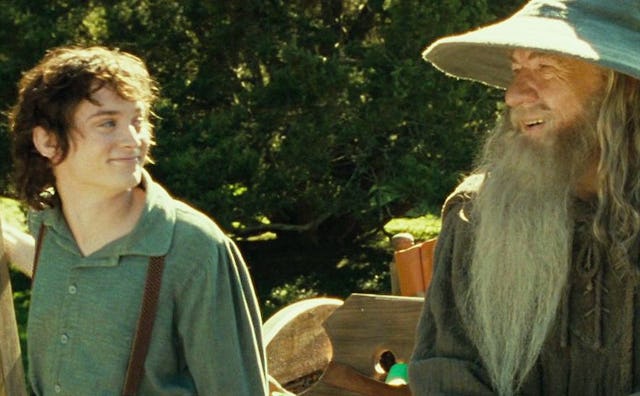5 Life Lessons My Kids Learned From The 'Lord Of The Rings' Movies

I’m a big fan of teaching kids important life lessons by plopping them in front of a television as often as possible.
Recently, I educated my offspring on the beauty of J.R.R. Tolkien’s worlds via the movies. We watched all of the Hobbit trilogy one weekend and the Lord of the Rings trilogy the following week. My kids are 8 and 10 years old, and some might think they’re a bit too young for those movies—or that we shouldn’t spend so much time in front of the boob tube.
I respectfully disagree.
I was a latchkey kid who watched a ton of television and movies. We’re talking hours and hours in front of the tiny black-and-white box without supervision. I still managed to grow up a healthy, social person with a great imagination. I think exposing my kids to hours on end of screen time is not only acceptable, but good for them.
The three of us sat in our designated spots in the dark for a total of 1,032 minutes together and came out on the other end better for it. I paused the movie at times to ask if they understood what was happening, and they did it, too, when they had their own questions. We talked through the confusing, held hands during the sad, cheered on the victories and laughed together at the funny (oh, those crazy dwarves!). I knew this was a great opportunity for them to see important life lessons in action, and I made sure to gently point them out. Here are five of these valuable lessons:
1. Thinking Of Others
Bilbo Baggins likes peace, order and being left the heck alone, but when Gandalf and the dwarves come by asking him to risk everything to help them reclaim their rightful home, he finds it in himself to step out of his comfort zone to do just that. Having empathetic kids would make me feel like I did something absolutely right.
2. Being Brave
Gandalf admits to Galadriel that seeing Bilbo be brave makes him braver. My kids actually asked me to explain this scene to them, so I broke it down like this: Gandalf is a very powerful wizard. If even he needs help being brave and can find that help in this hesitant Hobbit, you never know who is looking to you for inspiration to be better.
3. Accepting Differences In Others
Radagast the Brown is quirky, gives off a forgetful and flighty vibe, and has bird poop on his head, but everyone looks past all that and instead focuses on how kind he is and how valuable an asset he is to have in their lives. I’d love for my kids to treat the people they meet with the same kind of acceptance.
4. Learning To Trust
Legolas and Gimli initially butt heads due to past bad blood between the elves and the dwarves, but eventually become friends, fight side by side and trust one another with their lives. I bet my kids will have countless experiences butting heads with someone, or not understanding them, in their lives. Maybe, just maybe, they’ll give those people a chance to prove themselves and possibly build friendships as solid as those characters did.
5. Keep Trying
Whether you’re looking at Sméagol trying to shake the Gollum side of himself or Sam and Frodo fighting their way through the impossible to destroy the ring, there are endless examples of people (and creatures) simply not giving up or trying to do what’s right. We aren’t all good all the time or all bad all the time. My kids saw the many sides of these characters in action and saw them make mistakes, good decisions and bad decisions. The world is not black and white—and neither is our own journey to be who we want to be.
In real life, I can talk the Life Lesson talk all I want, but my kids hear me blathering on all day long and—I’m quite confident—tune me out on the regular. But when they dive into a movie with new voices, characters and scenarios that are a safe distance from their reality—and that reflect what they might have also been through—it somehow makes more of an impact. They ask questions more freely, wonder what the outcome might be, and comment on how that outcome makes them feel.
When my kids and I sink together into movies and television shows I know and love, two things happen: Their eyes open to what I’ve been trying to teach them all along, and I get to be a witness instead of the teacher. I love watching the wheels turn as they process the lessons unfolding on the screen. They get to feel whatever it makes them feel and understand the happy stuff and the hard stuff. And I get to sit by their side, a safety net of information and comfort, should they ever need me.
This article was originally published on